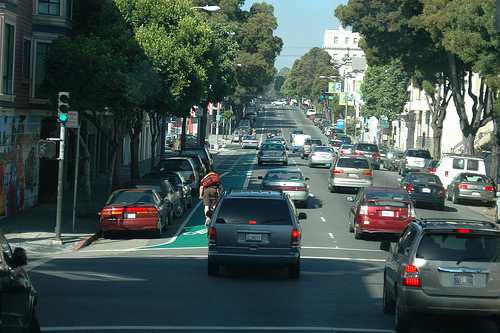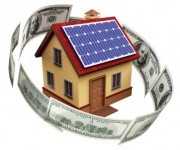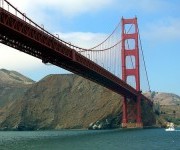 The new Fell Street bike lane.Photo: Elly Blue
The new Fell Street bike lane.Photo: Elly Blue
For the month of September, Elly Blue is traveling around the western U.S. as part of the Dinner & Bikes Tour, talking to local riders to learn about the bike economy and hear their stories over gourmet vegan meals. This week, Blue gets the scoop on bike-progressive San Francisco.
San Francisco, Calif.: At the end of 2009, a judge partially lifted a then-three-year injunction on building any new bike infrastructure. Ten projects came out of the gate fast, including a green bike lane on Market Street, a batch of sharrows (“share the road arrows”) scattered across the city, and a wealth of bike parking springing up in on-street spaces and on sidewalk’s edges everywhere. As we drove into town, it was exciting to see it all happening. But despite outward appearances, we’d soon learn that San Francisco’s bike-friendly makeover might only be skin-deep.
The 20 people who turned out to discuss San Fran’s biking future first watched me as I went through my war-room routine, which this time consisted of me standing by a sheet stretched across the living room windows and pointing at pictures of freeways and bike parking, asking them: What are the external costs? What are the benefits?
Audiences so far have been most engaged in listing the benefits of bicycling. I’m usually able to suggest one or two ideas, but this transportation-savvy group (which included a transportation reporter and a city traffic engineer) covered most of them on their own. This was lucky, because this was my first run without notes. While I paused to think, and they’d fill in my gaps with solid ideas of their own. “Another external benefit of bicycling is it can help communities thrive economically — people can do their shopping locally without the incentives to drive to a big box store,” said Dave Snyder, head of the newly minted California Bicycle Coalition. Snyder had certainly done his homework: He’s just back from his own two-week tour of meeting with bike advocates around the state, and he’s now working on organizing the state’s first-ever bike summit this October.
San Francisco’s bike injunction lasted four years total, and famously paralyzed the building of any new bike infrastructure until an environmental impact statement was completed. The blockage was largely the effort of one citizen who wanted paperwork to prove that bikes weren’t slowing traffic and increasing pollution. After the environmental review was completed at the end of 2008, the city went ahead with some prominent new bikeways, including the green one on Market Street. (A judge fully lifted the injunction last year.)
Watching from Portland in 2009, we had high hopes for San Francisco to build four years’ worth of pent-up bike infrastructure all at once — maybe this was the city that could even surpass us in bike progress, we thought. Their plans are certainly impressive: The San Francisco Bicycle Coalition has an ambitious vision in their Connecting the City campaign, which would edit a grid of north-south and east-west streets across the city to create a safe, comfortable network of bikeways across the peninsula.
But so far San Francisco has been all promise and little progress. I wondered if the build-out had stalled, and a woman in the audience confirmed that the process has been frustratingly slow. She suspected that the city was gunshy after the injunction, and reluctant to start planning and building when it could happen again. Nods around the room confirmed this suspicion. “Portland feels safe to ride in, and here it feels dangerous,” said another woman in the audience who has lived in both cities.
But a little perspective shows there’s hope yet for a bike utopia in SF. The next day we met a young man who said he was pretty sure he was the only bike rider in Daly City, a South Bay suburb. He described riding in his own city as a nightmare, and riding in San Francisco as a dream. “They have new bike lanes cropping up every week,” he said, eyes lit with enthusiasm.
Despite the kudos from the burbs, most audience members agreed that internal changes are need to ensure San Francisco lives up to its image. They acknowledged San Francisco’s leadership excels at marketing its bike friendliness — but in reality, less than 1 percent of its transportation funding goes for bikes. “We need to make a real investment in this stuff,” said one audience member.
“But what do we do? How do we make that happen?” asked the first woman.
I’ll pose that question to you: When the people want bike infrastructure, but the government is timid or reluctant, what do we do?



